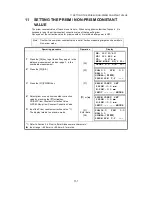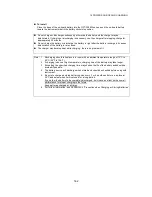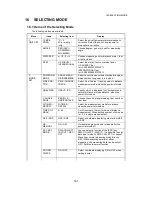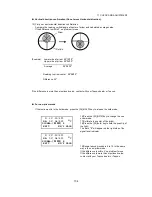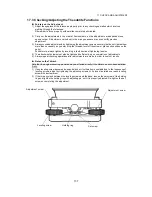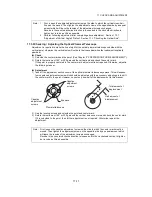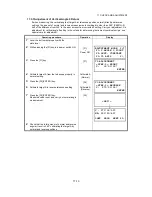
17-1
17 CHECK AND ADJUSTMENT
17
CHECK AND ADJUSTMENT
17.1 Checking and adjusting of instrument constant
Normally, the instrument constant does not have discrepancy. It is recommended you measure and
compare with an accurately measured distance at a location where the precision is specifically
monitored on a consistent basis. If such a location is not available, establish your own base line over
35m (when purchasing the instrument) and compare the data measured with the newly purchased
instrument.
In both cases note that the setup displacement of the instrument position over the point, the prism,
baseline precision, poor collimation, atmospheric correction, and correction for refraction and earth
curvature determine the inspection precision. Please keep in mind these points.
Also, when providing a base line in a building, please note that differences in temperature greatly affect
the length measured.
If a difference of 5mm or over (Prism mode) or 10mm or over (Non-prism mode) is the result from the
comparative measurement, the following procedure as shown below could be used to change the
instrument constant.
The procedure of Prism mode and Non-prism mode is the same. However, use a prism for prism mode
or a white board for non-prism mode as a target.
1) Provide point C on a straight line, connecting straight line AB which is almost level and about 100m
long. Measure straight lines AB, AC and BC.
2) Obtain the instrument constant by repeating 1) above several times.
Instrument constant = AC+BC–AB
3) When there is error between written instrument constant value and calculated value, review
Section 17.4 “How to Set the Instrument Constant Value”
4) Once again, measure at a calibrated baseline and compare results.
5) If using above procedure and no difference is found from the instrument constant at the factory or a
difference of over 5mm or over (Prism mode) or 10mm or over (Non-prism mode) is found, contact
TOPCON or your TOPCON dealer.
Note:
Each of the Prism mode and Non-prism mode has instrument constant.
You must check the instrument constants in each mode and obtain the instrument constants
of Prism mode and Non-prism mode.
●
If you reset the instrument constant of prism mode ( Prism-long), you must vary the prism
constant (Prism-short) by the same quantity as the amount of increase or decrease of the
instrument constant of the prism mode ( Prism-long).
●
If you reset the instrument constant of non-prism mode ( Non-prism-long), you must vary the
prism constant (Non-prism-short, Non-prism-middle) by the same quantity as the amount of
increase or decrease of the instrument constant of the non-prism mode ( Non-prism-long).
A
C
B
Содержание GPT-3000W Series
Страница 1: ...GPT 3000W SERIES GPT 3002W GPT 3003W GPT 3005W GPT 3007W PULSE TOTAL STATION INSTRUCTION MANUAL...
Страница 2: ......
Страница 140: ...12 4 12 SETTING ATMOSPHERIC CORRECTION...
Страница 141: ...12 5 12 SETTING ATMOSPHERIC CORRECTION...
Страница 181: ...APPENDIX 5...
Страница 182: ...Bluetooth and the Bluetooth logos are trademarks owned by Bluetooth SIG Inc USA and licensed to Topcon Corporation...
Страница 183: ......

